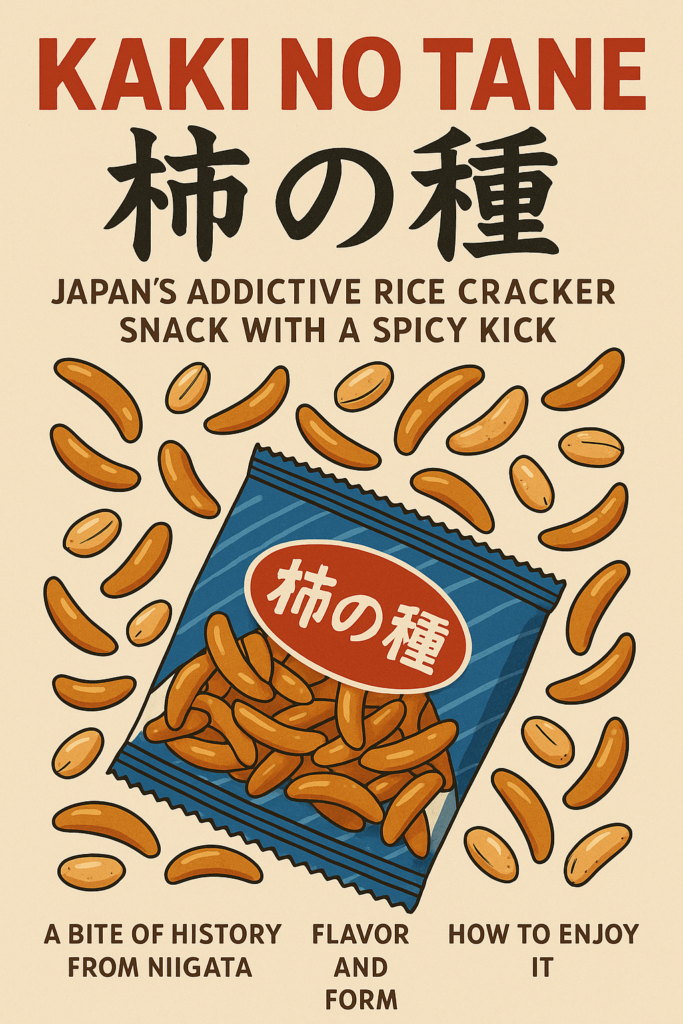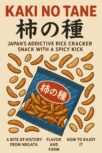
When it comes to Japanese snacks that have earned a cult following both at home and abroad, Kaki no Tane stands out as a crunchy, spicy favorite. This humble rice cracker—named after its resemblance to persimmon seeds (“kaki no tane” in Japanese)—is more than just a snack; it’s a symbol of Japanese snacking culture that carries a rich regional identity, particularly rooted in Niigata Prefecture.
A Bite of History from Niigata
Kaki no Tane was first created in the 1920s by a confectioner in Niigata, a region known for its exceptional rice production. Legend has it that the crackers got their signature shape when a mold for round senbei (rice crackers) was accidentally broken and replaced with a crescent-shaped one. The shape stuck—and so did the name.
Niigata’s high-quality rice and pristine water make it the perfect birthplace for this beloved snack. To this day, many of Japan’s top Kaki no Tane manufacturers, like Kameda Seika, are still based in Niigata, and locals take pride in the product as a true hometown hero.
Flavor and Form
The classic Kaki no Tane is a mixture of spicy soy-sauce flavored rice crackers and roasted peanuts. The combination of crunch, saltiness, and mild heat makes it dangerously easy to devour an entire bag in one sitting. Variations abound, including wasabi, ume (plum), curry, and even chocolate-coated versions. Some omit peanuts altogether, while others emphasize bold regional flavors.
How to Enjoy It
- With Beer: Kaki no Tane is a staple bar snack in Japan. The crisp texture and punchy flavor pair perfectly with a cold pint of beer.
- As a Topping: Crushed Kaki no Tane can be sprinkled over salads, soups, or rice for an added crunch and flavor boost.
- On the Go: Thanks to individually packed mini-bags, it’s easy to enjoy as a travel snack or quick bite at work.
A Snack for All Seasons—and All Regions
Though it started in Niigata, Kaki no Tane is loved across the country. In fact, different regions sometimes offer their own local spins on the snack. For example, in the Kansai area, you might find a sweeter or lighter soy sauce version. Meanwhile, in Tohoku, some varieties include dried squid for extra umami.
柿の種:ピリッとした刺激がクセになる、日本のやみつき米菓スナック
日本国内外で熱狂的な人気を誇るスナックの中で、「柿の種」はそのカリッとした食感とスパイシーな風味で際立っています。この素朴な米菓は、その形が柿の種に似ていることから名付けられたもので、単なるスナックを超え、日本のスナック文化の象徴とも言える存在です。特に新潟県に深く根ざした地域色を持っています。
新潟から始まる物語
柿の種は1920年代に新潟の菓子職人によって初めて作られました。新潟は優れた米の産地として知られており、このスナックの誕生にもその質の高い米が深く関わっています。伝説によると、丸い煎餅の型が壊れてしまい、代わりに三日月型の型で焼いたところ、偶然この独特な形になったそうです。この形がそのまま定着し、「柿の種」という名前になりました。
新潟の良質な米と清らかな水は、この愛されるスナックの誕生に最適な環境でした。現在でも、日本の主要な柿の種メーカーの多く(例えば亀田製菓など)は新潟に本社を構えており、地元の人々にとっては誇るべき郷土の味です。
味と形の魅力
クラシックな柿の種は、醤油ベースのピリ辛な米菓とローストピーナッツのミックスです。カリッとした食感、塩気、そしてほどよい辛さが相まって、つい一袋丸ごと食べてしまう中毒性があります。味のバリエーションも豊富で、わさび味、梅味、カレー味、さらにはチョコレートがけのものまで存在します。ピーナッツが入っていないものや、地域の特色を生かした強い味のものもあります。
食べ方いろいろ
- ビールと一緒に: 柿の種は、日本では定番のビールのおつまみです。カリッとした食感とパンチのある味は、冷たいビールとの相性抜群です。
- トッピングとして: 砕いた柿の種は、サラダ、スープ、ごはんの上などにふりかけると、食感と風味をプラスできます。
- 携帯スナックとして: 小分けパックが多く、移動中や仕事の合間などに気軽に楽しめます。
四季を通して、全国に愛されるスナック
新潟で生まれた柿の種ですが、今では日本全国で親しまれています。地域ごとに独自の味が展開されていることもあります。たとえば関西では甘めや薄味の醤油味が多く、東北では乾燥イカを加えて旨味を強めたものも見られます。
